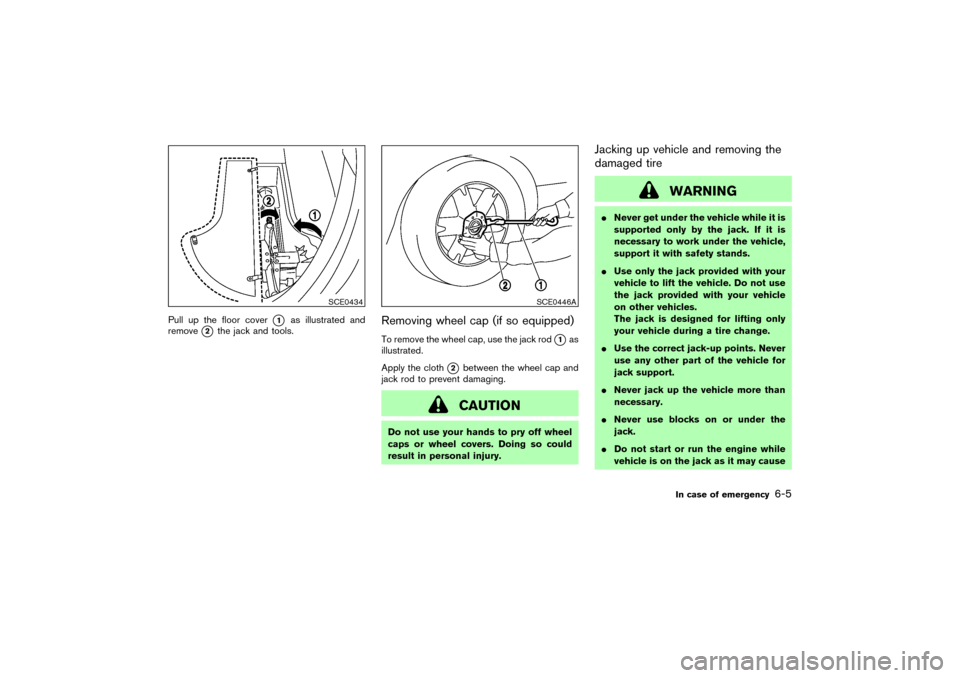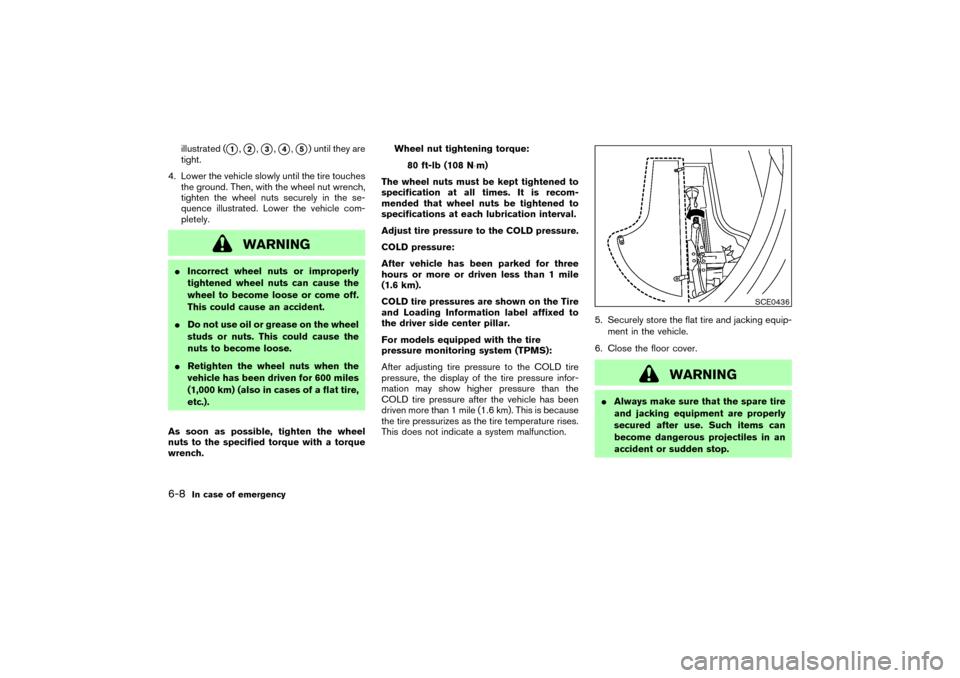Page 247 of 345
Getting the spare tire and toolsPull up the floor cover and hang the strap
�A
to
upper body
�B
as illustrated. Remove the under
tray
�C
(if so equipped).
Remove the jacking tools and spare tire from the
storage area located under the floor cover as
illustrated.Type A:
Turn the retainer counterclockwise
�1
and re-
move the spare tire.Type B:
Turn the retainer counterclockwise
�1, remove
the subwoofer
�2
and remove the spare tire.
SCE0528
SCE0529
Type A
SCE0530
Type B
6-4
In case of emergency
�
06.7.5/Z50-D/V5.0
�
Page 248 of 345

Pull up the floor cover
�1
as illustrated and
remove
�2
the jack and tools.
Removing wheel cap (if so equipped)To remove the wheel cap, use the jack rod
�1as
illustrated.
Apply the cloth
�2
between the wheel cap and
jack rod to prevent damaging.CAUTION
Do not use your hands to pry off wheel
caps or wheel covers. Doing so could
result in personal injury.
Jacking up vehicle and removing the
damaged tire
WARNING
�Never get under the vehicle while it is
supported only by the jack. If it is
necessary to work under the vehicle,
support it with safety stands.
�Use only the jack provided with your
vehicle to lift the vehicle. Do not use
the jack provided with your vehicle
on other vehicles.
The jack is designed for lifting only
your vehicle during a tire change.
�Use the correct jack-up points. Never
use any other part of the vehicle for
jack support.
�Never jack up the vehicle more than
necessary.
�Never use blocks on or under the
jack.
�Do not start or run the engine while
vehicle is on the jack as it may cause
SCE0434
SCE0446A
In case of emergency
6-5
�
06.7.5/Z50-D/V5.0
�
Page 251 of 345

illustrated (
�1,�2,�3,�4,�5) until they are
tight.
4. Lower the vehicle slowly until the tire touches
the ground. Then, with the wheel nut wrench,
tighten the wheel nuts securely in the se-
quence illustrated. Lower the vehicle com-
pletely.
WARNING
�Incorrect wheel nuts or improperly
tightened wheel nuts can cause the
wheel to become loose or come off.
This could cause an accident.
�Do not use oil or grease on the wheel
studs or nuts. This could cause the
nuts to become loose.
�Retighten the wheel nuts when the
vehicle has been driven for 600 miles
(1,000 km) (also in cases of a flat tire,
etc.).
As soon as possible, tighten the wheel
nuts to the specified torque with a torque
wrench.Wheel nut tightening torque:
80 ft-lb (108 N⋅m)
The wheel nuts must be kept tightened to
specification at all times. It is recom-
mended that wheel nuts be tightened to
specifications at each lubrication interval.
Adjust tire pressure to the COLD pressure.
COLD pressure:
After vehicle has been parked for three
hours or more or driven less than 1 mile
(1.6 km).
COLD tire pressures are shown on the Tire
and Loading Information label affixed to
the driver side center pillar.
For models equipped with the tire
pressure monitoring system (TPMS):
After adjusting tire pressure to the COLD tire
pressure, the display of the tire pressure infor-
mation may show higher pressure than the
COLD tire pressure after the vehicle has been
driven more than 1 mile (1.6 km). This is because
the tire pressurizes as the tire temperature rises.
This does not indicate a system malfunction.5. Securely store the flat tire and jacking equip-
ment in the vehicle.
6. Close the floor cover.
WARNING
�Always make sure that the spare tire
and jacking equipment are properly
secured after use. Such items can
become dangerous projectiles in an
accident or sudden stop.
SCE0436
6-8
In case of emergency
�
06.7.5/Z50-D/V5.0
�
Page 258 of 345

VEHICLE RECOVERY (Freeing a
stuck vehicle)
�1Remove the hook cover from the bumper
using a suitable tool.
�2Securely install the hook. (The hook is stored
with jacking tools.)
Make sure that the hook is properly secured in
the stored place after use.
WARNING
�Stand clear of a stuck vehicle.
�Do not spin your tires at high speed.
This could cause them to explode
and result in serious injury. Parts of
your vehicle could also overheat and
be damaged.
CAUTION
�Tow chains or cables must be at-
tached only to the vehicle recovery
hooks or main structural members of
the vehicle. Otherwise, the vehicle
body will be damaged.
�Never tow a vehicle using the vehicle
tie downs or recovery hooks.
�Always pull the cable straight out
from the front or rear of the vehicle.
Never pull the vehicle at an angle.
�Pulling devices should be routed so
they do not touch any part of the
suspension, steering, brake or cool-
ing systems.
�Pull devices such as ropes or canvas
straps are not recommended for use
in vehicle towing or recovery.
If your vehicle is stuck in sand, snow, mud, etc.,
use the following procedure:
1. Turn off the Vehicle Dynamic Control (VDC)
system.
SCE0531
SCE0444
Tie down and recovery hook
In case of emergency
6-15
�
06.7.5/Z50-D/V5.0
�